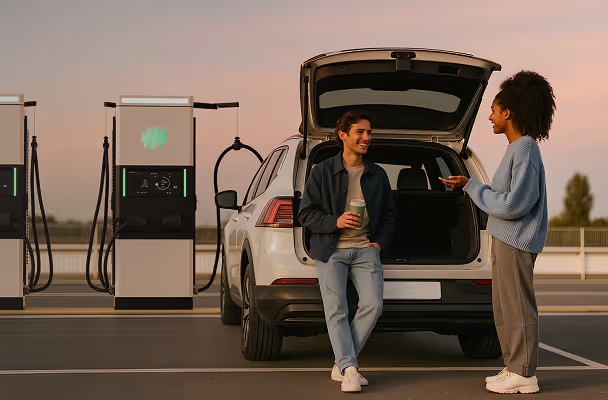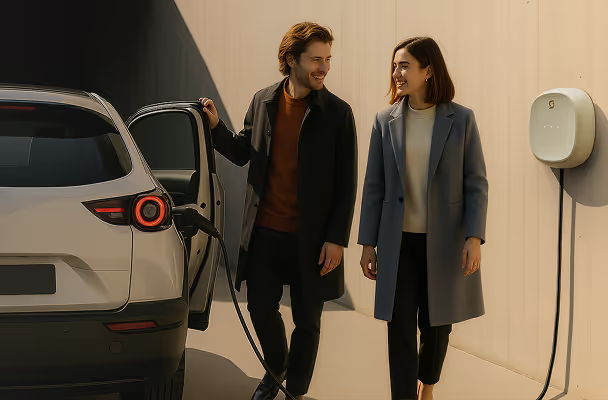All About EV Charging

Electric cars became a reality long ago, and now they are turning reliable With Electric Vehicles (EVs) quickly normalizing a clean commute, the buzz around EVs has surged more in recent times than ever before. On that note, let’s try to understand some of the more commonly discussed subjects around EV charging.
What is Smart EV Charging?
In essence, smart charging aims for a bidirectional flow between the charger and the EV, and engulfs features like Dynamic Load Balancing and Vehicle-to-Grid (V2G).
Dynamic Load Balancing
Dynamic load balancing ensures that the power drawn by the EV charger is receptive to energy usage depending on the electricity need. By avoiding the overuse of electricity, it gives more power to appliances that need it most and makes sure that the power use never crosses an upper limit. If it reaches its limit, the output of the EV charger might slow down or pause temporarily.
Vehicle-to-Grid(V2G)
Allows for EVs to effectively push power back into the grid to sizeable supply fluctuations. Such a two-way flow of energy also makes it a viable substitute for fuel generators in times of power cuts. Moreover, so can be efficiently stored in EV batteries and supplied on demand, making it disruptive when deployed at scale.
Cost AnalysisBetween: Home Charging and publicPublic EV Charging Stations
How Charger Capacity Affects EV Charging Time?
The charger’s capacity depicts the amount of power it can provide.
Level-1 Chargers
Level 1 chargers deliver around 2.3 kWh (or a range of 6 to 8 km per hour). Also, these chargers are usually considered as the slowest types of EV chargers.
Level-2 Chargers
Level two chargers provide at least 7.4 kWh or 11 kWh of power. With advanced versions, they are commonly can even give 22 kWh, adding around 40 km, 60 km, or 120 km per hour to your range. However, these fast charging speeds need skilled installation, both at homes and businesses.
Level-3 Chargers
Level three chargers, also known as DC or fast chargers, can provide up to 350 kWh of power. More commonly, you'll find outputs like 50 kWh, 125 kWh, and 150 kWh. They can charge an EV up to 80% in under an hour. However, these chargers need big transformers, making them expensive for homes.
Other Factors Impacting EV Charging Time
The capacity of an EV charger directly determines the power it can deliver and influences its performance substantially.
- Not all electric vehicles (EVs) are universally compatible with the high 350 kWh fast charging outputs. For this reason, certain models are designed to operate within lower ranges, typically between 100 kWh and 150 kWh. The charging duration is significantly influenced by the vehicle's charging capacity. For instance, certain cars might utilize only 7.4 kWh or 11 kWh out of the total 22 kWh slow AC charging capacity available.
- The battery’s state of charge affects an EV’s charging time. Due to internal chemical compositions, charging from 20% to 70% takes way less time than charging it from 70% to full. Moreover, the car battery’s size also dictates the charging duration.
- Weather conditions play a significant role in the charging speed of electric vehicles (EVs). During extreme temperatures, EV batteries need extra energy to maintain their internal temperature, which slows down charging. Typically, batteries work best around 21°C for optimal performance.
Conclusion
In conclusion, examining the major EV charging aspects—from smart charging tactics and associated costs to charger capacity and factors affecting charging time—provides a thorough understanding of the dynamics of Electric vehicle chargers affecting informed decisions. In the constantly changing world of sustainable mobility, it is essential to comprehend these aspects to make well-informed and maximize the effectiveness of the charging process.
Frequently Asked Questions
Lorem ipsum dolor sit amet, consectetur adipiscing elit, sed do eiusmod tempor incididunt ut labore et dolore magna aliqua. Ut enim ad minim veniam, quis nostrud exercitation ullamco laboris nisi ut aliquip ex ea commodo consequat. Duis aute irure dolor in reprehenderit in voluptate velit esse.
Lorem ipsum dolor sit amet, consectetur adipiscing elit, sed do eiusmod tempor incididunt ut labore et dolore magna aliqua. Ut enim ad minim veniam, quis nostrud exercitation ullamco laboris nisi ut aliquip ex ea commodo consequat. Duis aute irure dolor in reprehenderit in voluptate velit esse.
Lorem ipsum dolor sit amet, consectetur adipiscing elit, sed do eiusmod tempor incididunt ut labore et dolore magna aliqua. Ut enim ad minim veniam, quis nostrud exercitation ullamco laboris nisi ut aliquip ex ea commodo consequat. Duis aute irure dolor in reprehenderit in voluptate velit esse.
Lorem ipsum dolor sit amet, consectetur adipiscing elit, sed do eiusmod tempor incididunt ut labore et dolore magna aliqua. Ut enim ad minim veniam, quis nostrud exercitation ullamco laboris nisi ut aliquip ex ea commodo consequat. Duis aute irure dolor in reprehenderit in voluptate velit esse.
Lorem ipsum dolor sit amet, consectetur adipiscing elit, sed do eiusmod tempor incididunt ut labore et dolore magna aliqua. Ut enim ad minim veniam, quis nostrud exercitation ullamco laboris nisi ut aliquip ex ea commodo consequat. Duis aute irure dolor in reprehenderit in voluptate velit esse.



